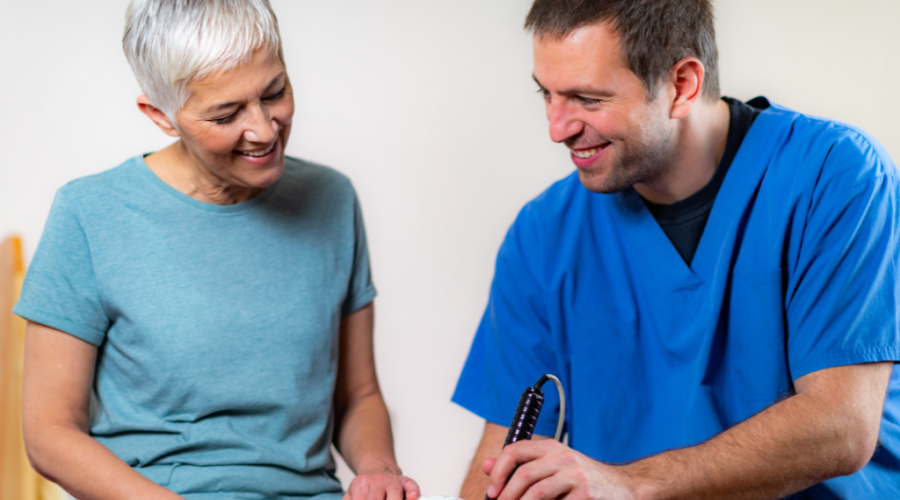
Allied Health Treatment Techniques: Cold Laser Therapy

Cold laser therapy, also known as low-level laser therapy (LLLT) and photobiomodulation therapy (PBM), may be administered by a physiotherapist, occupational therapist, or chiropractor. PBM is used to stimulate cellular function and promote tissue repair for conditions like chronic back pain, neck pain, shoulder pain, and pain associated with surgery, as well as soft tissue injuries like carpal tunnel syndrome, rotator cuff injuries, and plantar fasciitis.
PBM was pioneered in 1967 by Hungarian physician Professor Endre Mester. Mester began his laser research in 1965 with the goal of destroying tumors, but he instead observed that low-level laser irradiation stimulated tissue repair and hair regrowth in his experiments. This unexpected discovery led to the development of PBM.
PBM is based on blue- and red-light therapy and only penetrates soft tissue. PBM has been shown to increase anti-oxidative potential, reduce inflammation, improve circulation, reduce swelling, stimulate cellular repair, and reduce pain.
What to Expect During Cold Laser Therapy
Before Treatment
Your treating clinician will conduct a thorough assessment and physical exploration to determine how you would benefit from incorporating laser into your treatment session. Your clinician will ensure there are no contraindications to use laser on you. Once the assessment is done, your clinician will then explain how the laser will help with your pain and what to expect.
During Treatment
A small, handheld device is placed against the body on or near the site of pain. Your therapist will set the frequency using a specific protocol based on your concern. Most clients will report that they do not feel anything whilst some may experience a slight warming effect. Each target area is treated between 30 seconds and two minutes depending on your specific concern.
After Treatment
Some clients may experience immediate pain relief, whilst others may only notice an improvement after several sessions. Your therapist may choose to combine PBM with other therapies such as manual therapy, dry needling, massage, or exercise. After treatment you can resume normal activity, however, your therapist may suggest some activity modifications.
The frequency of your appointments may vary depending on your condition. We usually recommend one to three sessions per week until symptoms ease, and once a week thereafter for long-term maintenance as required.
This article is not meant as medical advice. The information presented is for informational or educational purposes only and should not be taken as a substitute for professional medical advice from a qualified healthcare provider. Readers should consult their doctor or other medical professional for any health concerns or decisions.
Right at Home Allied Health is dedicated to delivering quality, patient-centred care across Australia. Our allied health services comprise chiropractic, exercise physiology, occupational therapy, optometry, osteopathy, physiotherapy, podiatry, psychology, and speech pathology. We also provide remedial massage therapy, clinical nutrition, clinical naturopathy, and clinical Pilates. Our mission is to improve the quality of life for those we serve by decoding health, happiness, and harmony. Discover, heal, and optimise your physical and emotional wellbeing with Right at Home Allied Health. Book a Discovery Session at your local clinic today.
*Some services may not be available in all locations. Please contact your local office to learn more about their in-clinic and at-home allied health and wellbeing services.